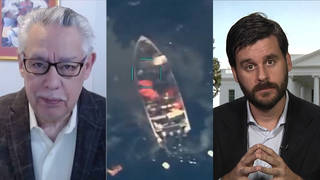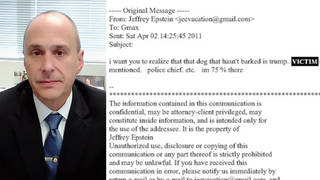
Guests
- Harriet Washingtonmedical writer and editor. She is a visiting scholar at DePaul University School of Law. Previously she was a fellow in medical ethics at Harvard Medical School and at Stanford University. She is the author of the new book, Medical Apartheid.
Medical scholar Harriet Washington joins us to talk about her new book, “Medical Apartheid: The Dark History of Medical Experimentation on Black Americans from Colonial Times to the Present.” The book reveals the hidden underbelly of scientific research and the roots of the African-American health deficit. It also examines less well-known abuses and looks at unethical practices and mistreatment of blacks that are still taking place in the medical establishment today. [includes rush transcript]
Transcript
JUAN GONZALEZ: A new report by the American Cancer Society shows that African Americans are still more likely than any other group to develop and die of cancer. The study states that socioeconomic factors play the largest role in this disparity. African Americans have less access to healthcare and information, and are less likely to get screening and medical treatment.
Well, a new book offers one answer into why black Americans deeply mistrust American medicine. Medical Apartheid: The Dark History of Medical Experimentation on Black Americans from Colonial Times to the Present is the first and only comprehensive history of medical experimentation, abuse and neglect of African Americans. The book reveals the hidden underbelly of scientific research and the roots of the African-American health deficit. It begins with the earliest encounters of blacks and the medical establishment during slavery, looks at how eugenics and social Darwinism were used to justify medical experiments conducted by the government and the military, and offers new details about the infamous Tuskegee experiments that began in the 1930s.
AMY GOODMAN: Medical Apartheid also examines less well-known abuses and looks at unethical practices and mistreatment of African Americans that are still taking place in the medical establishment today.
We’re joined now by the author of the book, Harriet Washington, a medical writer and editor, a visiting scholar at DePaul University School of Law. We welcome you to Democracy Now!
HARRIET WASHINGTON: Thank you. I’m very happy to be here.
AMY GOODMAN: Well, this is a fascinating book. First of all, why did you take it on?
HARRIET WASHINGTON: I took it on for two reasons: One, I’m a very naturally curious person, and when I was still in premedical undergraduate at the University of Rochester, I was working in a hospital and came across some case files that dramatically showed a disparity, a racial disparity, in people who were slated to receive kidneys, and that piqued my curiosity.
AMY GOODMAN: What do you mean?
HARRIET WASHINGTON: Well, I came across some old case files in a forgotten file folder, and one was of a black gentleman, one was of a white gentleman.
The white gentleman’s file was thick and full of testaments to his loving family, his insurance support, his determination to live, and detailed really Herculean attempt on the part of medical personnel to procure a kidney for him, kidney transportation still being relatively new then.
The file of the black gentleman was very thin. The word “Negro” appeared on every page of it, and somebody had underlined it on a social profile, right above the single line that indicated that the medical staff’s plans for him were to help him to prepare for his imminent demise.
The white gentleman and the black gentleman were very similar in their profiles, but they were treated differently, and I wanted to know whether this was a consistent feature of medical care or just an anomaly. And as I began looking into it, I just became intrigued in the vast differences in the way African Americans were used in research.
JUAN GONZALEZ: Well, your book doesn’t just deal with modern times, but you go back into the —- to actually the beginning of the country -—
HARRIET WASHINGTON: Absolutely.
JUAN GONZALEZ: — and exactly how these kinds of disparities began to manifest themselves. Could you talk to us a little bit about — especially about those early years, especially during the period of slavery?
HARRIET WASHINGTON: Right, the early years, it was quite chilling. First of all, it’s important to understand that there was a scientific animus called “scientific racism,” which at that time was simply science, and it posited that black people were very, very different from whites, medically and biologically. And this provided a rationale and an underpinning not only for the institution of slavery — slavery probably could not have persisted if there hadn’t been this medical underpinning — but also for the use of blacks in research.
For example, it said that blacks were less intelligent, sub-human, perhaps not even quite human, that they didn’t experience pain, that they were immune to diseases like malaria and heat sickness that made it impossible for whites to work in the field, but made them perfect for labor in the field. So this set of beliefs, this set of scientific beliefs, was not buttressed by any real data, but only by the needs of the community. And this actually gave permission for doctors to acquire slaves for research.
They also had a variety of conditions for which — a good example is reproductive health. All of the early important reproductive health advances were devised by perfecting experiment on black women. Why? Because white women could say no. White women were not interested in having doctors looking at their genitalia during the Victorian era, and white women were not interested in undergoing painful surgery without anesthesia, but black women could not say no.
So this animus began, as you say, in the very early days of our republic, and it simply snowballed until, by the time of the Civil War, blacks were being used, almost exclusively in some venues and in very high proportion in others, for everything, from vaccine design, experimental surgeries. And they were never consensual; you never asked their permission, and rarely were they therapeutic. They were mostly to expand medical knowledge.
AMY GOODMAN: We have to go to break. When we come back, I want to ask you about the Tuskegee experiment, which a lot of people know about it, but you say actually the emphasis on that obscures a lot of other experimentation that has gone on over the last centuries. We are talking to Harriet Washington. She is author of the book Medical Apartheid. We’ll be back in a minute.
[break]
AMY GOODMAN: We’re talking to Harriet Washington, who has written a quite remarkable book called Medical Apartheid. She is a medical writer and editor, visiting scholar at DePaul University School of Law, previously a fellow in medical ethics at Harvard Medical School, wrote for USA Today and also was a Knight fellow at Stanford University. Juan?
JUAN GONZALEZ: Before we come up to modern times, I’d like to get back to the slavery period. In your book, you talk about some — you document specific examples of some of the doctors who were involved in these ghoulish experiments. You mentioned a Dr. James Marion Sims and Dr. Walter F. Jones. Can you talk about some of the things that they practiced on slaves in those days?
HARRIET WASHINGTON: Right. James Marion Sims was a very important surgeon from Alabama, and all of his medical experimentation took place with slaves. He took the skulls of young children, young black children — only black children — and he opened their heads and moved around the bones of the skull to see what would happen, posited as a cure for disease, but there was no rationale for that. He also decided to remove the jawbone of a slave, but this slave was pretty intractable. He did not want the surgery. He loudly protested against it. And in response, Dr. Sims had him tied to a barber’s chair and held immobile, while he operated on him without anesthesia.
But he’s most infamous for his reproductive experiments with black women. He bought, or otherwise acquired, a group of black women who he housed in a laboratory, and over the period of five years and approximately 40 surgeries on one slave alone, he sought to cure a devastating complication of childbirth called vesicovaginal fistula. This cure entailed repeatedly doing incisions on their genitalia, very painful and, you know, very emotionally difficult, as you can imagine. And in the end, he claims to have cured one of them.
And after this, he went north, where his medical fortune was made. He became the toast of Second Empire Paris when he went there to be the personal physician of Princess Eugenie. And when he returned to New York, he was elected the president of the American Medical Association.
I think this is really important, because although often you speak of surgeons and doctors who do nonconsensual experimentation, and we think of these Frankensteinian characters, but the reality is these have tended to be overachieving adepts who were stellar physicians. They were well revered, well respected within their profession in their time, and people only knew of their work through their own bowdlerized versions of it. They wrote up these accounts in medical journals, but they never characterized them as abusive experimentation, because it was accepted for them that you operated on slaves who couldn’t say no.
AMY GOODMAN: Talk about Tuskegee, the Tuskegee experiment, though you write about how it obscures all others. A lot of people don’t even know about Tuskegee.
HARRIET WASHINGTON: That’s true. That’s true. Tuskegee is, you know, the icon of abusive experimentation of black people, but it’s true, many people still don’t know what happened, and there are a lot of misconceptions floating about, as well. So that’s a really good question, Amy.
What happened was that about 400 black men in Macon County, Alabama, with syphilis — who had been diagnosed with syphilis, at least — were studied over a period of 40 years by the United States Public Health Service. There were 200 men who were not infected who were held as a control group, also black men. Over the course of 40 years, these men were duped into thinking that they were in a treatment program. But they weren’t. They were given pain pills, which, as it transpired, were simply aspirin. They were given spinal taps, which, as it transpired, were not for the good of their health or to monitor their health, but rather to ensure a supply of sera for the development of a syphilis test. So they were used over 40 years, even after the advent of penicillin. When penicillin was recognized as a cure, it was withheld from these men.
JUAN GONZALEZ: And this was between — what was the 40-year span?
HARRIET WASHINGTON: 1932 to 1972.
AMY GOODMAN: How many people knew about this at the time? How did it stop?
HARRIET WASHINGTON: Hundreds of people knew about it, because there were regular reports in the medical journals, and it was actually presented at an American Medical Association meeting in 1965. There were also numerous meetings of governmental agencies, where they periodically would ask, “Should we continue the experiment or not?” And the decision was always, “Yes, we should continue the experiment.” It’s worth noting that the surgeon general, Thomas Parran, had taken on syphilis eradication as his mission, and yet when penicillin was devised and he had the cure, he made the decision to continue the experiment, because he said they represent an opportunity that will never come again.
AMY GOODMAN: What happened to the untreated men?
HARRIET WASHINGTON: The untreated men, as you can well imagine, many of them died horrible deaths. You know, they were not only infected with syphilis that was untreated, but these were also very poor men, sharecroppers. Their median income was a dollar a day. But being sharecroppers, they rarely saw any money. And they were debilitated beyond their years by syphilis and deprostrating labor. And so, many of them died, you know, very bad deaths from syphilis. They suffered — the secondary stage of syphilis is very painful. It constitutes running sores, you know, heart abnormalities, and the last stage of syphilis is devastating, neurologically devastating. Not everyone progresses to the last stage, you know, fortunately, but you can’t predict who will and who won’t, so everyone should be treated.
JUAN GONZALEZ: Now, this 40-year period obviously spanned both Democratic and Republican administrations in charge of the United States Public Health Service. Did your research uncover anybody who actually raised alarm and questioned — I mean, not just asked, “Should we continue it?” but actually tried to oppose, a call for an end to this experimentation?
HARRIET WASHINGTON: Two people. One was Dr. Irwin Schatz of Detroit, who wrote a letter to the Public Health Service after they published an article in a premier medical journal, and he said, “I’m shocked and astonished that you are permitting these men to continue dying of a treatable disease.” And there is a note attached to his letter by a physician who writes, “I’m not going to answer this.” And, indeed, they didn’t.
The other person was Peter Buxtun, and he was a young Polish immigrant who was responsible for ending the study, because he was a low-level interviewer with the Public Health Service, and he was shocked when he discovered it. He questioned it, at the risk of his job. He could easily have been dismissed, even for questioning it. And what I found really chilling is the fact that he would write these letters — very brave of him — protesting it, and after he wrote enough of them, these doctors called him into a room, where they all sort of sat arrayed against him, very intimidating, and lectured him, explaining to him the scientific process and why they were right to do this. Well, Buxtun didn’t agree. He left the PHS, went to law school, and through his entire three years of law school kept writing these letters. And when he got no response, when they gave him the same silent treatment Dr. Schatz had gotten, he called a journalist friend, and the AP ran the story. And the rest is history.
JUAN GONZALEZ: And are there any of the doctors who were involved in these experiments who are still practicing?
HARRIET WASHINGTON: Unfortunately, none of the doctors who conducted the experiment are alive. I say “unfortunately,” because I think one of the great tragedies of the study is that the miscreants have gone unpunished. I say their names whenever I can, because you never read of the names of the people who were the architects of the study. It was Thomas Murrell, O.C. Wenger. These men and Thomas Parran, others like them, perpetuated the study, and yet there’s been, you know, no — they were never accused of anything. Nothing castigated them. They apparently, obviously, have gotten off scot-free, and blame has been deflected on a nurse, you know, who was arguably the lowest person on the medical totem pole. And she has been made — Eunice Rivers has been made to bear the brunt of this study, when actually the people who devised it were never challenged.
AMY GOODMAN: When Clinton was president, he apologized to the survivors?
HARRIET WASHINGTON: Yes.
AMY GOODMAN: Were there any reparations?
HARRIET WASHINGTON: There weren’t reparations as such, but something very important did come out of the study materially, and that was the establishment of the National Center of Bioethics at Tuskegee University. That’s very important, because this is a bioethics center staffed and run by black people at a historically black university, and they have been working very hard to, number one, educate people about the real legacy of Tuskegee and also involve African Americans in bioethics, and specifically in the medical research process. So that was a very, very important result.
AMY GOODMAN: We’re talking to Harriet Washington, who has written the book, Medical Apartheid: The Dark History of Medical Experimentation on Black Americans from Colonial Times to the Present. Can you talk about Holmesburg Prison? And I ask about this, because there’s this latest news about a federal panel talking about loosening regulations around experimentation on prisoners. So, if you could address both?
HARRIET WASHINGTON: Sure. I’m actually going to start with the federal panel, which just a few months ago made a recommendation that prisons, which have been mostly closed to research since the 1970s, be reopened. This is a very bad decision, and although it’s not legally binding, all indications are that the government is going to take this recommendation to reopen prisons. And the reason why this is a problem is, if you look at the history of research in prisons, it’s been the site of the worst abuses, very troubled. There were experimental agents administered. Men were crippled, killed. There were mind-control experiments. And the worst thing about it is that the concept of consent in a prison is very problematic. The coercive nature of prison makes it very difficult for a prisoner to say no.
JUAN GONZALEZ: You also indicate that obviously a lot of this experimentation has continued. You have the one example in one chapter of a gentleman, Casper Yeagin, a 68-year-old retired auto mechanic who disappeared in 1977?
HARRIET WASHINGTON: Right.
JUAN GONZALEZ: Could you talk about that?
HARRIET WASHINGTON: Yeah. That case was quite chilling, because that’s where I talk about the use of blacks for anatomical dissection. When Yeagin disappeared, his family searched for him high and low, and they called the hospitals repeatedly and were told he wasn’t there. But he turned up to be on a laboratory slab, about to undergo dissection. He had died and was being dissected. And this indicates that black people have been used much more often for anatomical dissection against their will.
AMY GOODMAN: Where?
HARRIET WASHINGTON: Everywhere. Everywhere.
AMY GOODMAN: What laboratory on this slab, though, in this case of this man?
HARRIET WASHINGTON: Oh, this was interesting. Howard Medical School, which is a predominantly African-American school. Another theme of the book, which is a —
AMY GOODMAN: How did they find him? How did they know this was the man?
HARRIET WASHINGTON: Well, it turns out he was the only unidentified patient in the hospital during the time his family was told he wasn’t there. And the larger issue is that blacks are more likely to have their bodies taken for dissection. It’s a result of a long pattern of co-opting the bodies of slaves and then, later, of poor blacks. That’s less flagrant now, but still exists, so there’s a disparity.
JUAN GONZALEZ: So, in other words, hospitals might be in the practice of, if there’s an unidentified patient who dies, then using those bodies for dissection without thinking, well, this person belongs to some family — some family is looking for them — rather than to wait and see if they can be identified, and use them for experimentation?
HARRIET WASHINGTON: Yeah. And the system is actually set up to make certain people at higher risk, because the system actually says that if a patient dies in a hospital and no one comes to claim the body, it goes to the coroner’s office, and the coroner has the option of making the body available for dissection. Well, think about who dies without someone coming to claim the body: poor people, homeless people, who are more likely to be black or Hispanic.
AMY GOODMAN: I want to go back to Holmesburg Prison, because you’re talking about two kinds of experimentation there. There was the experimentation that you write about, where prisoners are injected with Staphylococcus and Monilia, herpes, other viruses. Also, the doctor in charge, Dr. Kligman, was also doing work for cosmetics companies?
HARRIET WASHINGTON: That’s right. Dr. Albert Kligman made a fortune doing this kind of work for pharmaceutical companies, and then also became rich working for the government. So, yes, he actually was a dermatologist who went way beyond his field to inject men, at the behest of pharmaceutical companies, with dangerous chemicals.
AMY GOODMAN: And cosmetics companies?
HARRIET WASHINGTON: And cosmetics, yeah.
AMY GOODMAN: So they make a kind of checkerboard — another book written, Acres of Skin.
HARRIET WASHINGTON: By Allen Hornblum, very good book.
AMY GOODMAN: Very interesting book, where the cover is a picture of a checkerboard of where they test different parts of the back of a man with different chemicals to see how they would react.
HARRIET WASHINGTON: Exactly.
AMY GOODMAN: And they would walk around as these checkerboards.
HARRIET WASHINGTON: Right. And, in fact, a prison guard said, when he went to the beach in the area, he could tell who had been in the prison by looking at the patterns on their backs.
AMY GOODMAN: And so, what’s come of this?
HARRIET WASHINGTON: Well, some of the survivors are still around and are suing — they’re trying to sue the university and Dr. Kligman, but Dr. Kligman himself has been honored, has never, you know, been castigated or sued, and so far they’ve been unsuccessful in their suit. Hornblum is actually helping them a great deal. You know, it’s wonderful of him.
AMY GOODMAN: Yeah, we interviewed him, and we’ll link on this broadcast to the show with the survivors of those tests at Holmesburg.
JUAN GONZALEZ: What about the issue of sterilization? I know — obviously in Puerto Rico throughout the 1940s and ’50s, there was a massive sterilization campaign. But what about the sterilization of African-American women?
HARRIET WASHINGTON: Oh, it’s very troublesome. African Americans have been more likely to be sterilized during the eugenics period, but even more recently, African-American women constitute 85 percent of the women who are forced to undergo a Norplant implantation for abusing their children.
AMY GOODMAN: And explain what Norplant is.
HARRIET WASHINGTON: Norplant is a contraceptive, no longer on the market, but it’s implanted in the woman’s arm, and it confers sterility for five years, at least. All kinds of medical problems resulted, though, you know, from depression to weight gain to physical problems, and it was taken from the market eventually.
AMY GOODMAN: And who was experimented on with it?
HARRIET WASHINGTON: Oh, black women, black girls in the Baltimore school system. Baltimore is 82 percent black, so these girls were also like 95 percent black.
AMY GOODMAN: Did they understand that they were part of an experiment?
HARRIET WASHINGTON: No. It wasn’t presented as an experiment. It was presented as, as The Philadelphia Inquirer said, a way to reduce the underclass, a solution to the teenage pregnancy problem. But it’s very short-sighted. Teenage pregnancy has its roots in, you know, a wide variety of medical and social issues, and an implanted capsule is not going to cure it.
JUAN GONZALEZ: You also talk about experiments or investigations done on black adolescents who have behavior problems.
HARRIET WASHINGTON: Right, who are alleged to have behavior problems, yeah. And also on black boys, specifically, who they think might have a genetic predisposition to violence. But there’s no rationale for only looking at black boys. If you’re looking at predisposition for violence, you should be looking at all boys, and most American boys, of course, are white. But it’s black boys who have been singled out for these very dangerous experiments, such as a fenfluramine experiment that took place right here in New York City between 1992 and 1997.
JUAN GONZALEZ: What was that about?
HARRIET WASHINGTON: Oh, they took, let’s see, from 110 to 36 black boys and gave them fenfluramine, which is half of that Phen-Fen drug that was taken off the market, because it was cardiotoxic, caused heart problems. They gave it to these boys in an attempt to see whether they would show some inclination toward violence. And they found the boys, because the boys were the younger brothers of children already in the juvenile justice system, so that was coercive in itself. They used the juvenile justice system to identify boys. And again, the protocol, which I read, only indicates black boys are eligible. White boys were not eligible.
AMY GOODMAN: We’re talking to Harriet Washington, author of Medical Apartheid. We’ll be back with her in a minute.
[break]
JUAN GONZALEZ: I’d like to ask you again about some of these experiments on children. There was a Mississippi neurosurgeon that you write about, Orlando J. Andy, who was doing this experimentation in the ’60s and 1970s?
HARRIET WASHINGTON: Yes. Very, very troubling experimentation. Essentially, what he was doing was he was taking institutionalized young black boys and cutting out parts of their brain. Now, his rationale for doing that was that they had, quote-unquote, “behavior problems,” but there’s no psychologist report. Andy was not a psychologist, but a neurologist. There was no indication that they had behavioral problems. And if you consider that during this period in the Deep South, the very narrow range of acceptable behaviors for black boys — you know, you think about the Emmett Till case, which has renewed interest now, he was murdered for whistling at a white woman. So what did these boys do to justify Andy taking out parts of their brain?
The most chilling aspect of this is that Andy is revered as a hero. His university is very proud of his work.
AMY GOODMAN: His university is?
HARRIET WASHINGTON: University of Mississippi. And if you look at the medical literature, you won’t find any indication that he did anything untoward.
JUAN GONZALEZ: And you’re saying he was conducting brain surgery on children that were otherwise not ill?
HARRIET WASHINGTON: I’ll say that he was conducting brain surgery on children for which there was no evidence of illness. No one offered any evidence, except his own statement that the boys had a behavior problem. And, you know, what’s a behavior problem? Most six-year-old boys are very annoying at some point, if not permanently, so why were these young boys treated this way?
JUAN GONZALEZ: And what was the involvement of the parents of these children? You’re saying they were mostly institutionalized.
HARRIET WASHINGTON: Right, which means the parents are removed from the equation. And that’s a problem with black children. They’re much more likely have their parents removed from the informed consent equation. They’re more likely to be institutionalized than white children.
AMY GOODMAN: We’re talking to Harriet Washington, who’s written Medical Apartheid, and you also have recommendations, talking about the issue of African-American suspicion of the medical system and the practice of experimentation moving from the United States to developing countries, to Africa.
HARRIET WASHINGTON: Right. Well, in terms of African-American suspicions, there are two parts to that. There’s the [inaudible] untrustworthiness of the system. In terms of exportation of research to Africa, highly problematic. A lot of the abuse in African Americans has dissipated, but that kind of research is being conducted in Africa, where the people are in the same situation. They don’t have rights. They don’t have access to medical care otherwise, and Africa is being treated as a laboratory for the West by Western researchers. Very troublesome.
JUAN GONZALEZ: You mention specifically the EZ measles vaccine?
HARRIET WASHINGTON: Yeah, that’s a very good example. A vaccine that killed hundreds of children in Brazil and Africa was then used in Los Angeles on parents who had no idea that the vaccine was experimental. They were only told that their children were being vaccinated.
AMY GOODMAN: The Edmonton-Zagreb?
HARRIET WASHINGTON: Edmonton-Zagreb, yeah. Named after the two cities where it was perfected.
AMY GOODMAN: Your recommendations?
HARRIET WASHINGTON: My recommendations, first of all, are, I’m very concerned about the erosion of informed consent in this country. We have more and more laws that are watering down informed consent. In 1996, the government decided that emergency room patients could be used in experiments without their consent. And I say we have to stop this, here and abroad.
We also have to institute a program of patient education. People go into medical research with no idea what their rights are and how to protect themselves. Researchers are trained, as I was when I was at Harvard Medical School, and we have to extend the same advantage to subjects and patients.
And finally, African Americans have got to take charge of this issue. We can’t afford to avoid medical research now. It’s too much part of treatment. But we have to learn to protect ourselves, so we have to make this an issue, as we have done with AIDS and environmental racism, and begin educating ourselves and militating for better treatment.
AMY GOODMAN: And what about the issue of payment for being part of an experiment?
HARRIET WASHINGTON: Well, I always find that problematic, because researchers — and they may sincerely believe this — say that it’s not payment, but just like an indication of goodwill. A hundred dollars is an indication of goodwill, if you’re a wealthy professor at Harvard Medical School. But if you’re a poor woman living in Washington Heights, $100 can be an inducement. So I am against payment. I’m much more in favor of educating people and spending money there.
JUAN GONZALEZ: And what about some of these institutions that have participated in some of these horrific experiments in the past, in terms of them coming forth, apologizing, being held accountable for what they’ve done in the past?
HARRIET WASHINGTON: Personally — apology sounds good, but I’m not a great fan of it, because I think that in one sense it allows you to duck responsibility. I mean, rather than a verbal statement, I would much rather see, you know, material resources applied toward educating and assisting African Americans in medical research.
AMY GOODMAN: Well, I want to thank you very much for being with us and for doing this remarkable historical and contemporary look at experimentation on African Americans. The book is called Medical Apartheid: The Dark History of Medical Experimentation on Black Americans from Colonial Times to the Present. The author is Harriet Washington, who was an ethics fellow at Harvard Law School, also was a fellow at Stanford University, is now a visiting scholar at DePaul University School of Law, wrote for USA Today, and Medical Apartheid is her book.












Media Options